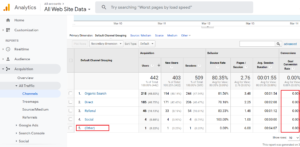In the digital era, no marketers can survive without mastering data, analytics, and automation; the reason is a massive surge in data generation. Suppose you look at the stats about data generation. In that case, it’s more than 2.5 quintillions of data generated every day, which equals 2.5, followed by stupefying 18 zeros according to social media today.
“And by 2025, the amount of data generated each day will surge to 463 exabytes of data globally, according to the world economic forum.”
And the fun part is the words that humans have spoken fit into only five exabytes of data. Now imagine the importance of mastering data, analytics, and automation and why it is crucial today? You probably have got your answers by now.
But to stand out in the market and beat your competitors, you need to understand the ongoing and upcoming trends. How can you analyze them seamlessly? Through machine learning and advanced automation.
And in this blog, we’re going to learn how machine learning can enhance marketing in the highly competitive world. Remember, you’re not alone in the race, but you need to think and act a step in advance to beat your competitors.
If you get what I mean, let’s dive in and explore them in detail.
7 Coolest Ways Machine Learning Can Enhance Your Marketing
Marketing success depends upon many significant factors, from proper customer research to building the brand strategy, engaging with the customers, and delighting them; it takes a lot of effort and automation.
And to solve these massive problems, ease the marketer’s work and responsibilities through accurate data analysis, machine learning has enormous roles to play. And here is the complete breakdown of how machine learning influences marketing.
Understanding Customers in 360-degree
Every day, your customers share information about themselves, but the best thing you can do is spend most of your time where your customers love to spend. When you start paying attention, you start knowing them better and better.
You get to know your customer’s last purchase, their problems, and how you and your products can help them. When you understand their pain points and are able to fulfil their needs and predict what they are likely to purchase the next time, understand the psychology behind it – you get the 360-degree view of customers.
Real-Time Analytics Gives You On-going and Up-coming Trends
Today, in the digital era, the world is changing so fast that it’s tough to comprehend data, and that’s one reason why business decisions keep changing from time to time. Because the whole thing is when you’re up to the final decision in the making, more and more data gets bombarded.
A few free tools from Google are Google Keywords, Google Analytics, and Google Search Console. When you use them, you get the exact data you need to understand the ongoing and upcoming trends and how your competitors do the same for any location and product.
According to Gartner, real-time analytics is a discipline that requires logic and mathematics to make better decisions quickly. And again, according to Gartner’s research, by 2022, most companies will incorporate real-time analytics to push their firm to the ultimate level and stay ahead of their competitors — just to improve decision making.
Smart Engine Recommendations is the Smartest Move Ever
Businesses run on data, and that’s so true, but where does the data come from? From users, right? Yes, whenever you visit a website or purchase a product, the website cookies track everything, and from there, the analyst can know what other things you would be interested in and like to buy.
And they push you to do similar things when you visit their website. Let’s suppose you purchased an iPhone at this Great Indian Festival; what Amazon will show you next, the phone charger, the case, and tempered glass, saying people who have purchased iPhones have also purchased these items.
How does Amazon do that? Amazon does that using KNN algorithms, using smart engine recommendations. That’s the most intelligent move over.
Predictive Engagement and Analytics (Just a Few Steps Away)
The first step of data analytics is to be able to understand the data, meaning when you know the data, you know customers and what they are looking for. From there, you might know what they might actually purchase.
And predictive analytics is all about that; it’s the likelihood of customers taking a particular action and companies using different software for the accurate prediction.
The best example is “The Big Billion Sale” campaign by Flipkart. If you have looked closely, you have seen the best deals, only seven left, and many different tactics to boost sales while the price fluctuates.
When you’re about to purchase, the order gets out of stock, and again it gets available. Or something you can relate to wherever the new flagship phone launches, there are limited sales every week and delivery to the first registered customers until the device is fully available.
Chatbots are the New and Ultimate Sales Persons
Nowadays, if you see every website, it has something called chatbots, and it is NLP enabled, meaning it’s a self-learning algorithm that learns by itself. With this, you don’t need to be active on a website 24 X 7.
Chatbots are your new and ultimate sales AI-Robots and can guide your visiting customers by understanding their search intent, helping you collect the leads, and later you can turn them into customers.
Personalization is the New Customer-Centric Emotion
When you look into it from different perspectives, you can always relate to customers being emotion-driven; when you present them in the right way and poke their pain points, they are most likely to take action.
But when you personalize them, addressing them with their name, they feel ‘This company is customer-centric and valued their customers a lot. And that’s what hooks them to your business.
The best way to do this is through email marketing, and we have so many tools for the same with self-learning algorithms that automate the whole process with personalization.
Voice Search is the New Generation of Search Optimization and Search Engine
In the digital era, and with many advanced features on mobile and web apps, our life has become more sophisticated. People were hardly interested in typing out their queries but voice-searched them.
That’s what the world’s largest eCommerce platform, Amazon, does brilliantly with Alexa implementation. It works on the principle of Natural Language Processing, where it captures the audience queries, looks for the best matches and related to them through the KNN algorithm, and showcases the most relevant items to the customers with matching keywords.
That way, Amazon makes the marketing and business model easy for the end-users and holds their customers for a long time.
Conclusion
When you read the whole thing, you learn how advanced and essential machine learning has become and how crucial it is to integrate into the business models.
These seven machine learning algorithms have already been game-changing. If you’re a business owner or stakeholder, you must plan to implement them in your business to see it scaling.









